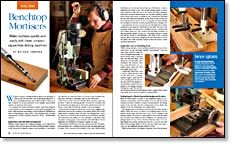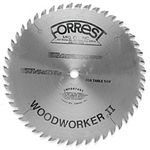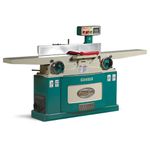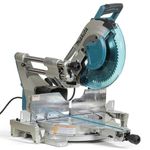Benchtop Mortisers
Make mortises quickly and easily with these compact, square-hole-drilling machines
Synopsis: When it comes to cutting mortises, there is no shortage of ways to get the job done. One of the most efficient is to use a mortising machine, also called a hollow-chisel mortiser. Roland Johnson put eight current benchtop mortisers to the test: Bridgewood HM-11, Delta MM300, Delta 14-651, Fisch BTM99-44252, General International 75-050T, Jet JBM-5, Shop Fox W1671, and Woodtek 138-224, to see how they stack up against each other.
When it comes to cutting mortises, there is no shortage of ways to get the job done. One of the most efficient is to use a mortising machine, also called a hollow-chisel mortiser. Properly set up and operated, it cuts straight, square-sided mortises in relatively short order.
To compare the current benchtop models, I had them shipped to my shop for a close examination. Once all the unpacking was done, eight machines were sitting on my workbench: Bridgewood HM-11, Delta MM300, Delta 14-651, Fisch BTM99-44252, General International 75-050T, Jet JBM-5, Shop Fox W1671, and Woodtek 138-224.
A good fence and hold-down are important
The fence helps support the workpiece during a cut. It adjusts front to back so that you can align the chisel with the mortise location. It also keeps the workpiece square to the machine, so successive cuts will line up with each other. On several of the mortisers, the fence also provides a mounting point for the hold-down.
The fences on the General and Woodtek mortisers were my favorites. I liked the miter-gauge-like bar and slot assembly and the sturdy fence-locking system. If I had to pick between the two fences, I’d go with the General, simply because it’s bigger.
Each machine includes a hold-down. As the name suggests, the hold-down prevents the workpiece from lifting off the table as the chisel and bit withdraw from the hole. The Bridgewood, Fisch, Jet, Shop Fox, and both Delta mortisers have a horseshoe-shaped, cast hold-down that slides on a rod mounted to the fence (see top photo, facing page). Once secured, each hold-down did an admirable job holding the workpiece against the table.
The standout hold-downs are the General and the Woodtek. Both machines have a sliding hold-down that was especially easy to adjust. Two cutouts in the middle of the fence allowed the hold-down to be lowered below the top of the fence, a feature shared by the Delta 14-651. The cutouts made it easier to secure stock narrower than the fence. Of course, the other machines were able to secure narrow stock, too, but they needed a spacer block made from scrap. In addition, the General and Woodtek are the only benchtop mortisers in this review with a front vise (see bottom photo, below). A vise is a big plus because it keeps the workpiece anchored securely against the fence during a cut.
Only the Delta 14-651, General, Jet, and Woodtek have toolless methods for securing the hold-down to the shaft. The rest of the machines make you hunt down an Allen wrench. I much prefer the toolless approach. The General and Woodtek mortisers are almost entirely toolless, except for a chuck-key needed to install the drill bit. Nearly as user-friendly is the Delta 14-651; it needs only an Allen wrench that’s integrated into the chuck-key to secure the chisel. The other machines require at least two tools to make machine adjustments.
From Fine Woodworking #178
For the full article, download the PDF below:
Fine Woodworking Recommended Products

Forrest Woodworker II Blade

Grizzly G0495X Industrial Helical Cutterhead 8-in. Jointer

Makita LS1219L Miter Saw






















Log in or create an account to post a comment.
Sign up Log in